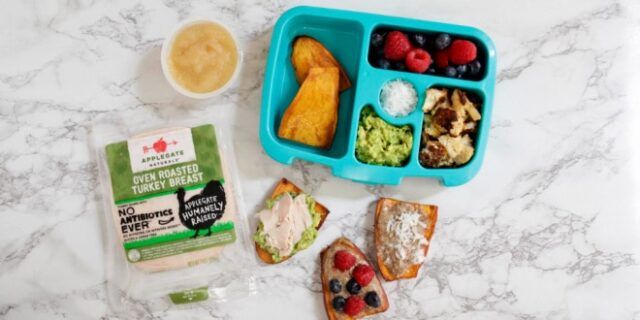The information on baby’s first foods is for educational purposes only. It is not intended nor implied to be a substitute for professional medical advice. Always consult your child’s healthcare provider to determine the appropriateness of the information for your own situation, or if you have any questions regarding your child’s healthcare plan.
The AAP recommends “breastfeeding as the sole source of nutrition for your baby for about 6 months.” Check with your child’s doctor about the recommendations for vitamin D and iron supplements during the first year. When you start introducing baby to solid foods, continue breastfeeding until at least 12 months. You can continue to breastfeed after 12 months if you and your baby desire.
By Stephanie Greunke, Dietitian
Baby’s first foods… introducing your baby to solid foods is an exciting milestone in the parenting journey (and I’m excited for you and your little one)! Once your pediatrician gives you the green light, and your baby is showing signs of readiness (usually around 6 months) you have lots of options and strategies for introducing solids, including baby-led weaning (self-feeding) or purees.
Before we begin, please know that there is not a “right way” to introduce solids. It really depends on your personal preferences, your infant’s developmental readiness and input from your pediatrician. Be patient with yourself and your little as you navigate this process, (and it IS a process).
As a parent, I have personal experience with this topic, and as a registered dietitian I’ve counseled many families as they introduce solid foods to their babies. I hear the same 6 questions about this topic over and over. I hope my answers help you work with your pediatrician to determine the methods and foods that work best for your sweet baby.
Baby’s First Foods: Which Foods Should You Introduce First?
Around six months of age, most nursing babies’ iron and zinc stores start to diminish and they need more than what can be provided through breast milk alone. This Journal of Nutrition article puts the iron and zinc needs of infants into perspective with this incredible statistic: “Infants need complementary foods with much higher nutrient density than is required for adult diets. For example, per 100 kcal of food, a breast-fed infant at 6–8 mo needs 9 times as much iron and 4 times as much zinc as an adult male.”
This is why iron-fortified infant rice or oat cereal is often recommended as an appropriate first food. However, current recommendations suggest that foods rich in heme iron (such as meat, poultry, and fish) are an excellent choice for first foods. They contain more bioavailable sources of iron than rice cereal and provide other important nutrients such as zinc, B6, and B12.
Since your little one may not be interested in or able to consume more than a few tablespoons, you want to make each small bite worth it! You can do this by choosing the most nutrient-dense options such as meat, fish, eggs, fruit, and vegetables.
Best first foods include those rich in iron, zinc, and omega-3 including:
- High-quality liver (Very small amounts are needed.)
- Beef
- Lamb
- Bison
- Poultry
- Sardines
- Oysters
- Salmon/salmon caviar
- Eggs
If your little one isn’t interested in meat, make sure to include foods rich in vitamin C with your plant-based source of iron to boost iron absorption. For example, pair a source of non-heme iron such as cooked, dark leafy greens, legumes, or fortified bread/grains with a side of sweet potato, mango, or cooked broccoli.
With any of these options you can choose to puree them or serve them baby-led weaning style. For example: blend chicken, beef, or lamb with breast milk, water, coconut milk, or broth as a puree or simply offer soft pieces of meat or flaky salmon that’s easy to hold and chew/mash with their gums or few teeth. A great book to show you how to do this is Born To Eat.
You can also try making meatballs or slow-cooked meat for your little one to enjoy. Some little ones love to gnaw on a piece of meat on the bone, chicken thighs or drumsticks (making sure small bones are removed) to begin tasting that type of food by swallowing the juices and experimenting with different flavors. Cut the meat with the grain if serving to baby to gnaw.
Soft or cooked fruit and vegetables that are generally well-tolerated by infants include:
- Sweet potato
- Winter squash
- Carrots
- Beets
- Mango
- Papaya
- Banana
- Avocado
- Kiwi
- Plums
- Peaches
- Apricots
- Pears
If those go over well, you can advance to options a little higher in insoluble fiber such as soft or cooked:
- Broccoli
- Cauliflower
- Cooked leafy greens
- Berries
If you’d like to use purees, you can make them at home, purchase them at a grocery store, or buy them online from Serenity Kids. You’ll love their purees that include protein, veggies, and healthy fats!
Simply mash softer foods with a fork, or use a blender/food processor to provide the texture appropriate for your baby. They’ll progress from more watery purees to thicker, chunkier purees.
If you’re doing baby-led weaning, you can offer baked, roasted, or steamed vegetables that are soft enough to mash between two fingers, served as long, holdable pieces.
Feel free to add oil and spices that your family enjoys. The goal is to introduce baby to as many flavors as possible during the first two years to increase the likelihood that they’ll enjoy them throughout their life. This may be a good opportunity to expand your palate and variety as an adult too! Next time you’re at the grocery store, pick out a fruit or vegetable you’ve never tried and shared that experience with your little!
How Should I Introduce Dairy and Grains?
If you’re interested in introducing dairy, organic, unsweetened, full-fat kefir and yogurt are great options. Cheese, ghee and butter are great too, just avoid full-fat cow’s milk until they’re at least 1 year old (more details on this below).
If you’re interested in introducing grains, soaked and/or sprouted grains are a great option, but just do your best with the time, resources and energy you have. Make sure you’re also offering a variety of other nutrient-dense foods along with grains. Many people I work with choose to wait until their baby is over a year to introduce grains. They focus on meat, fruits, veggies, and healthy fats first to boost the nutrient-density of their diet since they’re only able to eat small amounts of food.
Some families who personally avoid gluten and dairy in their house may decide to introduce small amounts of these foods to their baby during the first year. This is because new research is showing that early introduction of allergens might actually be protective against food allergies. This is different than what has been previously recommended, allergen avoidance during baby’s first 1-3 years.
You may wish to avoid all dairy and grains, which is okay; however, consider working with a nutritionist or dietitian trained in pediatric nutrition to make sure your little one isn’t missing out on important minerals
Are There Any Foods I Should Completely Avoid?
You’ll want to avoid cow’s milk until at least 12 months of age since early introduction may lead to iron deficiency (anemia), displace other important nutrients in the diet, and cause early cessation of nursing. Avoid honey until 12 months as honey may contain substances that can lead to infant botulism. Obvious choking hazards, such as raw nuts, should also be avoided. Ask your provider about any other foods to avoid, delay, or introduce with caution.
What About Introducing Baby to Solid Foods On a Specific Schedule?
Just like the Reintroduction period following a Whole30, experts generally recommended to “go slow” when introducing new foods. Some parents choose to give their baby one food at a time, every 3 days to more easily identify any food that may cause a reaction (such as gas, irritability, fussiness, excessive spit up, or skin irritations). Once their baby has tolerated a variety of foods and/or a few months have passed, they may choose to introduce combinations.
Of course, there are no set rules. You may decide that variety is important and going too slow isn’t necessary with foods that aren’t known allergens. If you’d like to introduce combinations of foods earlier on in the process and you have the go-ahead from your pediatrician, feel free! This makes it easier for parents who choose the baby-led weaning approach to offer food from their plate, which likely includes meals made with multiple ingredients.
How Much Food Should My Baby Eat?
Don’t be surprised or feel defeated if your little one refuses solids or eats a tiny portion during the first few attempts. This is totally new for them! My first son had no hesitation and leaped right into solids, but my second son took his time and started welcoming solids into his diet after a month of attempts. Both situations are totally normal and it may take even longer than a month for them to accept! As stated brilliantly by Ellyn Satter, your job is to offer food at mealtimes. Their job to accept or decline and decide how much.
The WHO recommends that “infants start receiving complementary foods at 6 months of age in addition to breast milk, initially 2-3 times a day between 6-8 months, increasing to 3-4 times daily between 9-11 months and 12-24 months with additional nutritious snacks offered 1-2 times per day, as desired.”
You may find that more food ends up on the floor than in your baby’s stomach. Don’t worry if your little one is only taking in a few teaspoons of solid foods each day (if any!). Keep offering, stay patient, and know it will come with time. Babies are all so different when it comes to solids, so please don’t compare your baby’s intake with what you see on Instagram or with other people’s kids.
If you’re nursing, experts generally advise to offer solids after a nursing session. This will help maintain your supply and prevent meltdowns from being overly hungry. Learning how to navigate solids is hard work for a baby, so make sure they’ve got at least a little energy in their system before introducing baby to solid foods.
What About Highly Allergenic Foods?
In the past, experts have recommended not to introduce highly allergenic foods (such as eggs, peanuts, tree nuts, cow’s milk, soy, wheat, fish and shellfish) until after an infant’s first birthday. According to the American Academy of Allergy, Asthma, and Immunology, “evidence has shown that there’s no reason to delay the introduction of the highly allergenic foods beyond 4-6 months of age. In fact, delaying the introduction of these foods may increase your baby’s risk of developing allergies.”
Of course, please talk to your baby’s pediatrician before introducing these highly allergenic foods especially if your infant has a reaction to any food, allergies run in your family, or if your infant has persistent skin issues (such as moderate to severe eczema) despite treatment.
If you’re concerned about introducing allergenic foods, you can always choose to introduce them during your child’s well-visit, so you’re near a healthcare provider in case something happens. You could introduce the food to your infant right before your visit (potentially even outside the building), since you’ll likely have to wait for your appointment. This will allow extra time for you to observe your baby’s reaction and you’ll be near help.
Note: Some of the links contained in this website are affiliate links. This means that we may receive a commission if you click on the link and make a purchase from the affiliate. We only recommend products and services that we know or trust to be of high quality, whether an affiliate relationship is in place or not.
















